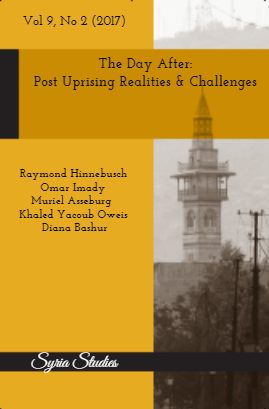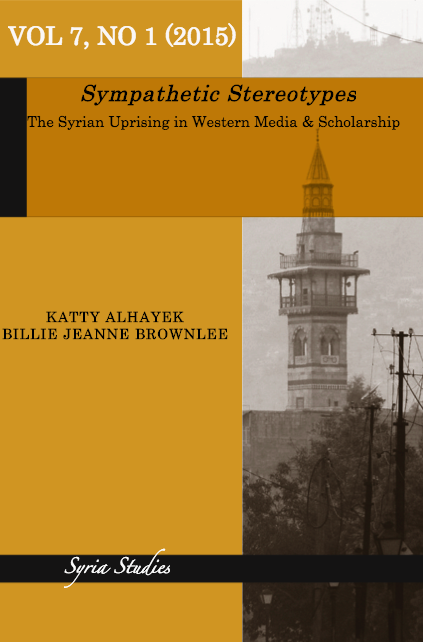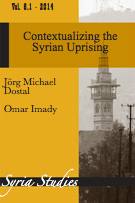Trends in Syrian Studies amidst internal war
Vol. 16 No. 1 (2025)
This issue, Vol 16, No 1, of Syria Studies explores the impact of Syria’s internal war on research and analysis of Syria in the more the more than decade beginning soon after the outbreak of the Syrian uprising. Contributors write from the perspective of their own research and positionality as researchers from/of Syria. They explore such questions as: How do we conduct research amidst protracted war? What constitutes ‘the field’ when access to the country is virtually impossible for many of us? How are our research questions and methods shaped by the current state of protracted war? Abboud argues that the post-2011 period represents a new, fourth period that will shape Syrian state formation. Ghada Atrash’s essay forefronts how “epistemic activism” can disrupt knowledge production. Rula Jabbour examines the utility of Strategic Studies for iunderstanding the Syrian conflict. Sumaya Malas considers how the “post-conflict” framework discourages researchers from pursuing projects until conflicts are perceived to be over. Rimun Murad assesses the emergence of the war novel as a consequence of the conflict. Christa Salamandra’s reflection on ethnography on understanding Damascene elites. Uğur Ümit Üngör asks how the Syrian conflict has affected the conduct of wider international politics. Fadi Skeiker personal testimony centres on theatre as a practice of citizenship and social justice. Alexa Firat examines visual narratives of the conflict.
From Governance to Refugees
Vol. 15 No. 2 (2023)
From Governance to Refugees
This issue contains articles spanning the spectrum from Syria’s pre 2011 politics and governance to the role and impact of refugees during the Syrian Uprising. First, Ahmad Mamoun explores the role of the military in politics in the 1954-58 period, when there was a unique interaction—a duality of power--between military activism and semi-democratic politics in the country. This paper provides an exceptionally rich insight into the complexities of Syrian politics. Equally nuanced is the penetrating analysis by Armenak Tokmajyan of “authoritarian conflict management” i.e. the “mechanisms of domination” deployed by the Syrian Ba’th regime, which he shows to be a subtle combination of threat of violence, co-optation and use of local intermediaries. In the third contribution, Line Khatib analyses how the regime has sharply centralized and institutionalized its mechanisms of control over the Sunni religious field since the Uprising and Iranian intervention. In their paper, Umut Ozkaleli and Sean Byrne examine opposition governance under Local Councils and the Syrian Interim Government through the lens of the perceptions of Syrian refugees of their performance. Finally Ahmad Barakat continues the focus on refugees, specifically critiquing perceptions in Europe of a security risk from them by looking at the experience of Syrian refugees in Germany.
Great Power Competition in the Syrian Conflict
Vol. 15 No. 1 (2023)
In this issue of Syria Studies , we are pleased to share five studies that focus on intervention in the Syrian conflict by Great Powers. In this era of “great power competition,” Syria has been the target of rival powers seeking to affect outcomes, with, in particular, Russia and China backing the government and the US the opposition.
The first chapter by Raymond Hinnebusch gives a overview of the “New Struggle for Syria” engaging the US, Russia and China, that provides a macro-context for the subsequent studies. It looks at how these powers shaped a proxy war over territorial spheres of influence that metamorpized into an economic struggle waged around US sanctions over reconstruction. The second chapter, by Mohammad Kanfash, conceptualizes sanctions as siege warfare, and exposes the humanitarian harm that sanctions have imposed on Syrian civilians. The following study by Ferdinand Arslanian exposes the factors that determine whether sanctions succeeded, as intended, in dissociating the business elites from the regime, namely whether their business activity was mostly domestic or international and their degree of political integration into the regime. In the fourth study Muhammed Abu Hasan examines how Russia tried to generate soft power in Syria through humanitarian deliveries and instrumentalization of religious networks around the Orthodox church and the Chechen leader, Kadyrov. The last study by Dan Wang analyzes why China’s mediation diplomacy in the Syrian remained low profile—the few national interests at stake, its limited leverage over the parties and the intractability of the conflict. Altogether, the studies provide a multifaceted portrait of the objectives, strategies, and consequences of the intervening powers in the Syrian conflict. They combine meticulous original empirical cast in analytical frameworks that throw welcome new light on the New Struggle for Syria.
Interventions and Spill-overs: External Aspects of the Syrian Uprising
Vol. 14 No. 1 (2022)
In the first issue of Syria Studies to be published in 2022, we are pleased to share several studies that provide important insights on external—regional and international--aspects of the Syrian conflict. They either represent instances in which the conflict spills over, affecting Syria’s relations with other regional actors or interventions in the conflict by external actors.
In Omnibalancing: the case of Hamas and the Syrian Regime Ashraf Mousa analyses the relation of Hamas with the regime through the lens of Omni-balancing theory. In Understanding a Decade of Syria-Hamas Relations, 2011-2021, Nasrin Akher identifies and explains the key phases and watersheds in the relation of the two. Between them, these two studies provide a thorough analysis of how the negative “spillover” of the Syrian Uprising disrupted a relation that had been a key dimension of the ”Resistance Axis,” with consequences for the regional balance of power.
The third study looks at two external interventions in the conflict that sought to mediate between the parties, one by the United Nations mediators focused on the Geneva process and one by Russia and its Turkish and Iranian partners in the Astana negotiations. It compares the differing impacts of two quite different approaches to mediation. This analysis in located within—and throws new light on--the theoretical debates over approaches to mediation.
Seven Years of Research on the Syrian Conflict
Vol. 13 No. 1 (2021)
tribal elements of Syria’s society and political system and their role in the Uprising of 2011. Continuing with the theme of social and political authority, Rana Khalaf explores the nature of state building and governance during periods of conflict in the country. This is followed by an account of the emergence of Syrian civil society’s political voice by Tamara al-Om, and an investigation by Diana Bashur into the sales of arms by America and Europe to the Middle East during the first three years of the Uprising. Joanne Hopkins next analyses the theme of coercive control in the context of the Syria conflict. Focussing on the reconstruction process, Omar Imady examines how the rebuilding process is being weaponized by various players in the region. Lastly, Dina Ramadan offers an in-depth exploration of the implications of the digital age for Syrian politics, and how harnessing the power of the internet may facilitate much-needed change.
Narratives of Transformation
Vol. 12 No. 1 (2020)
We are pleased to present VOL 12, NO 1, Narratives of Transformation. This issue of Syria Studies includes three articles: “The Digital Party as a Vehicle for Transformational Political Change in Arab Spring Countries: Opportunities for Syria” by Dina Ramadan; “Military and Politics in Syria (1946-1963): Alliances, Conflicts and Purges” by Khouloud Al Zghayare; and “The Images of Syrian Refugees in the Mainstream Narrative: A
Case Study of Lebanon” by Ahmad Barakat.
Post-Uprising Excavations
Vol. 11 No. 2 (2019)
We are pleased to present VOL 11, NO 2, Post-Uprising Excavations. This issue of Syria Studies includes three articles: “UN Mediation in the Syrian Crisis: From Kofi Annan Through Lakhdar Brahimi To Staffan De Mistura” by I William Zartman; “Palestinians in the Syrian Uprising: The Situation on the Ground” by Ashraf Mousa; and “No Temple in Palmyra! Opposing the Reconstruction of the Temple of Bel” by Andreas Schmidt-Colinet.
Nine years after the Uprising began in Syria, historians and political analysts are embarking on what might be called ‘excavations,’ or a deeper introspection into the forces at work during these past nine years, and how the current status quo is reflective of the way in which these forces reinforced or cancelled out each other. In this issue of Syria Studies, examples of this intricate analytic process are provided by an array of distinguished, and emerging scholars.
Against all Odds: Intricate Dynamics of Syria’s Reconstruction
Vol. 11 No. 1 (2019)
Untold Stories Gender-sensitive readings of the Syrian Uprising
Vol. 10 No. 1 (2018)
In this new issue of Syria Studies, entitled Untold Stories – Gender-sensitive readings of the Syrian Uprising, we are pleased to share two samples of a new and promising approach to analysing and interpreting the narrative of war. It is an approach that is not only preoccupied with the human dimension of political conflict, but also one that seeks to shed light on the gender-specific nuances that permeate such dynamics. Indeed, it is now widely accepted that ideas of masculinity have had a significant impact on the way in which politics is understood and analysed, often skewing our perspective of what exactly is taking place. When applied to the realm of Syria studies, employing a more gender sensitive approach can help us capture the stories that are often untold, or brushed aside; stories of women and men attempting to assert their identity in a political context that is often adamant at denying them this right.

























